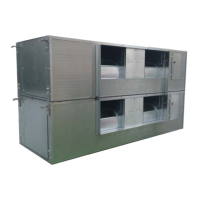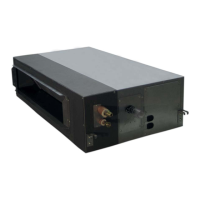Do you have a question about the Hitachi RPI-10FSNE and is the answer not in the manual?
Guidelines for proper disposal of the air conditioner to protect the environment.
Mandatory requirements for handling and labeling refrigerants under EC Regulation.
Step-by-step guide to correctly fill out and attach the F-Gas label.
Definition and use of DANGER, WARNING, and CAUTION signals for safety.
Classification of indoor units by type (Cassette, Ceiling, etc.) and their model numbers.
Listing of outdoor unit models and identification of heat pump variants.
Critical safety instructions for operating the air conditioner.
Key information regarding system setup, usage, and potential hazards.
Specified temperature ranges for optimal cooling and heating performance.
Details on the high-pressure vessel and its safety device to prevent system overpressure.
Components and operational modes of the air conditioner system.
Essential checks and procedures to follow before starting the unit.
Overview of the liquid crystal remote control and its display.
Detailed explanation of each button's purpose on the remote control.
Steps for selecting cooling, heating, dry, or fan modes via the remote.
Instructions for adjusting temperature, fan speed, and air flow direction.
How to control swing louvers and set timer operations.
Procedures for ventilation and automatic temperature control modes.
Specific instructions for adjusting swing louvers on various cassette and wall-type units.
Explanation of normal operation indicators like Thermo-controller, Defrost, and Filter status.
Understanding error indications for abnormalities, power failures, and electric noise.
Description of automatic functions such as frost prevention and defrost cycles.
Guidance on identifying and resolving common operational problems.
Diagram and list of parts for the RASC-5HNE outdoor unit.
Diagram and list of parts for the RASC-10HNE outdoor unit.
Illustrations showing refrigerant flow in single and twin system configurations.
Safety warnings and spatial requirements for installing the outdoor unit.
Information on concrete foundations, suspended units, and available configurations.
Guidance on selecting ducts based on fan performance charts for optimal operation.
Guidelines for selecting and preparing copper piping materials.
Methods for properly suspending refrigerant piping to prevent vibration and damage.
Instructions for connecting refrigerant lines, including torque specifications.
Details on connecting flange pipes and applying the correct tightening torque.
Charts and examples for determining suitable piping lengths based on system configuration.
Guidance on selecting pipe sizes and installing distributors for multi-system configurations.
Procedures for tightening flare nuts and performing brazing with safety precautions.
Instructions and calculations for charging the correct refrigerant amount.
Methods for calculating additional refrigerant needed for longer piping runs.
Instructions for correctly connecting the drain piping on the outdoor unit.
Ensuring proper selection and compliance of electrical components before wiring.
Diagrams illustrating electrical connections for outdoor units.
Guide to configuring DIP switches for various operating modes and functions.
Procedures and precautions for wiring indoor and outdoor units together.
Tables for determining appropriate wire sizes according to electrical standards.
Description of the H-Link system, its application, and communication features.
Instructions for setting DIP switches for various system configurations in H-Link.
Reference to a separate manual for remote control installation details.
Important safety warnings and checks before performing the test run.
Step-by-step guide for conducting a test run using the remote control.
Procedure for test running using outdoor unit DIP switches and functions.
Details on internal thermostats, fuses, and safety devices for indoor units.
Specifications for outdoor unit pressure switches, fuses, and sensors.
List of alarm codes, their causes, and leading causes for troubleshooting.
Solutions for problems related to unit operation, indicators, and fan speed.
Troubleshooting steps for issues affecting cooling or heating performance.
Guidelines for proper disposal of the air conditioner to protect the environment.
Mandatory requirements for handling and labeling refrigerants under EC Regulation.
Step-by-step guide to correctly fill out and attach the F-Gas label.
Definition and use of DANGER, WARNING, and CAUTION signals for safety.
Classification of indoor units by type (Cassette, Ceiling, etc.) and their model numbers.
Listing of outdoor unit models and identification of heat pump variants.
Critical safety instructions for operating the air conditioner.
Key information regarding system setup, usage, and potential hazards.
Specified temperature ranges for optimal cooling and heating performance.
Details on the high-pressure vessel and its safety device to prevent system overpressure.
Components and operational modes of the air conditioner system.
Essential checks and procedures to follow before starting the unit.
Overview of the liquid crystal remote control and its display.
Detailed explanation of each button's purpose on the remote control.
Steps for selecting cooling, heating, dry, or fan modes via the remote.
Instructions for adjusting temperature, fan speed, and air flow direction.
How to control swing louvers and set timer operations.
Procedures for ventilation and automatic temperature control modes.
Specific instructions for adjusting swing louvers on various cassette and wall-type units.
Explanation of normal operation indicators like Thermo-controller, Defrost, and Filter status.
Understanding error indications for abnormalities, power failures, and electric noise.
Description of automatic functions such as frost prevention and defrost cycles.
Guidance on identifying and resolving common operational problems.
Diagram and list of parts for the RASC-5HNE outdoor unit.
Diagram and list of parts for the RASC-10HNE outdoor unit.
Illustrations showing refrigerant flow in single and twin system configurations.
Safety warnings and spatial requirements for installing the outdoor unit.
Information on concrete foundations, suspended units, and available configurations.
Guidance on selecting ducts based on fan performance charts for optimal operation.
Guidelines for selecting and preparing copper piping materials.
Methods for properly suspending refrigerant piping to prevent vibration and damage.
Instructions for connecting refrigerant lines, including torque specifications.
Details on connecting flange pipes and applying the correct tightening torque.
Charts and examples for determining suitable piping lengths based on system configuration.
Guidance on selecting pipe sizes and installing distributors for multi-system configurations.
Procedures for tightening flare nuts and performing brazing with safety precautions.
Instructions and calculations for charging the correct refrigerant amount.
Methods for calculating additional refrigerant needed for longer piping runs.
Instructions for correctly connecting the drain piping on the outdoor unit.
Ensuring proper selection and compliance of electrical components before wiring.
Diagrams illustrating electrical connections for outdoor units.
Guide to configuring DIP switches for various operating modes and functions.
Procedures and precautions for wiring indoor and outdoor units together.
Tables for determining appropriate wire sizes according to electrical standards.
Description of the H-Link system, its application, and communication features.
Instructions for setting DIP switches for various system configurations in H-Link.
Reference to a separate manual for remote control installation details.
Important safety warnings and checks before performing the test run.
Step-by-step guide for conducting a test run using the remote control.
Procedure for test running using outdoor unit DIP switches and functions.
Details on internal thermostats, fuses, and safety devices for indoor units.
Specifications for outdoor unit pressure switches, fuses, and sensors.
List of alarm codes, their causes, and leading causes for troubleshooting.
Solutions for problems related to unit operation, indicators, and fan speed.
Troubleshooting steps for issues affecting cooling or heating performance.
| Brand | Hitachi |
|---|---|
| Model | RPI-10FSNE |
| Category | Air Conditioner |
| Language | English |












